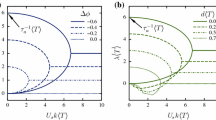Abstract.
We present a theoretical study of the behaviour of two active particles under the action of harmonic traps kept at a fixed distance away from each other. We classify the steady configurations the squirmers develop as a function of their self-propelling velocity and the active stresses the swimmers induce around them. We have further analyzed the stability of such configurations, and have found that the ratio between their self-propelling velocity and the apolar flow generated through active stresses determines whether collinear parallel squirmers or perpendicularly swimming particles moving away from each other are stable. Therefore, there is a close connection between the stable configurations and the active mechanisms leading to the particle self-propulsion. The trap potential does not affect the stability of the configurations; it only modifies some of their relevant time scales. We have also observed the development of characteristic frequencies which should be observable. Finally, we show that the development of the hydrodynamic flows induced by the active particles may be relevant even when its time scale orders of magnitude smaller than the other present characteristic time scales and may destabilize the stable configurations.
Similar content being viewed by others
References
E.M. Purcell, Am. J. Phys. 45, 3 (1977)
D. Bray, Cell Movements: From Molecules to Motility (Garland, New York, 2001)
M. Leoni, J. Kotar, B. Bassetti, P. Cicuta, M. Cosentino Lagomarsino, Soft Matter 5, 472 (2009)
R. Dreyfus, J. Baudry, M.L. Roper, M. Fermigier, H.A. Stone, J. Bibette, Nature 437, 862 (2005)
E. Lauga, Phys. Rev. Lett. 103, 088101 (2009)
W.F. Paxton, K.C. Kistler, C.C. Olmeda, A. Sen, S.K.S. Angelo, Y. Cao, T.E. Mallouk, P.E. Lammert, V.H. Crespi, J. Am. Chem. Soc. 126, 13424 (2004)
P. Tierno, R. Golestanian, I. Pagonabarraga, F. Sague, Phys. Rev. Lett. 101, 218304 (2009)
P. Tierno, O. Güell, F. Sague, Phys. Rev. E 81, 011402 (2010)
G.P. Alexander, C.M. Pooley, J.M. Yeomans, Phys. Rev. E 78, 045302 (2008)
P.T. Underhill, J.P. Herna, Phys. Rev. Lett. 100, 248101 (2008)
I. Llopis, I. Pagonabarraga, Europhys. Lett. 75, 999 (2006)
I. Llopis, I. Pagonabarraga, Eur. J. Phys. E 26, 103 (2008)
X. Wu, A. Libchaber, Phys. Rev. Lett. 84, 3017 (2000)
Y. Hatwalne, S. Ramaswamy, M. Rao, R.A. Simha, Phys. Rev. Lett. 92, 118101 (2004)
T.B. Liverpool, M.C. Marchetti, Phys. Rev. Lett. 97, 268101 (2006)
D. Marenduzzo, E. Orlandini, Soft Matter 6, 774 (2010)
D. Marenduzzo, E. Orlandini, M.E. Cates, J.M. Yeomans, Phys. Rev. E 76, 031921 (2007)
S. Ramachandran, P.B.S. Kumar, I. Pagonabarraga, Eur. Phys. J. E 20, 151 (2006)
G.I. Taylor, Proc. R. Soc. London, Ser. A 209, 447 (1951)
G.I. Taylor, Proc. R. Soc. London, Ser. A 211, 225 (1952)
A. Najafi, R. Golestanian, Phys. Rev. E 69, 062901 (2004)
C.M. Pooley, G.P. Alexander, J.M. Yeomans, Phys. Rev. Lett. 99, 228103 (2007)
M.J. Lighthill, Commun. Pure Appl. Math. 5, 109 (1952)
J.R. Blake, J. Fluid Mech. 46, 199 (1971)
T. Ishikawa, M.P. Simmonds, T.J. Pedley, J. Fluid Mech. 568, 119 (2006)
I. Llopis, I. Pagonabarraga, J. Non-Newtonian Fluid Mech. 165, 946 (2010)
T. Ishikawa, T.J. Pedley, Phys. Rev. Lett. 100, 088103 (2008)
P. Bartlett, S.I. Henderson, S.J. Mitchell, Philos. Trans. R. Soc. London, Ser. A 359, 883 (2001)
S. Chattopadhyay et al., Proc. Natl. Acad. Sci. U.S.A. 103, 13712 (2006)
A.D. Rowe et al., J. Mod. Opt. 50, 1539 (2003)
G.V. Soni, G. Ananthakrishna, G.V. Shivashankar, Appl. Phys. Lett. 85, 2414 (2004)
K. Maeda, Y. Imae, J. Shioi, F. Oosawaj, J. Bacteriol. 127, 1039 (1976)
G.W. Ordal, J. Bacteriol. 126, 706 (1976)
J. Tailleur, M.E. Cates, EPL 86, 60002 (2009)
S. Kim, S.J. Karrila, Microhydrodynamics. Principles and Selected Applications (Dover, Mineola, 1991)
R.M. Simmons, J.T. Finer, S. Chu, J.A. Spudich, Biol. J. 70, 1813 (1996)
K.C. Neuman, A. Nagy, Nature 5, 6 (2008)
Keqin Gu, V.L. Kharitonov, Jie Chen, Stability of Time-Delay Systems (Birkhäuser, Boston, 2003)
From the first-order dynamic system $\upd \mathbf{x}/\upd t = \mathbf{A} \cdot \mathbf{x}(t) + \mathbf{B} \cdot \mathbf{x}(t - \tau_d)$ we arrive at the characteristic equation $\Det (\mathbf{A} + e^{-\lambda \tau_d}\mathbf{B} - \lambda\mathbf{1}) = 0$ from which we can derive the eigenvalues $\lambda$
Author information
Authors and Affiliations
Rights and permissions
About this article
Cite this article
Matas Navarro, R., Pagonabarraga, I. Hydrodynamic interaction between two trapped swimming model micro-organisms. Eur. Phys. J. E 33, 27–39 (2010). https://doi.org/10.1140/epje/i2010-10654-7
Received:
Accepted:
Published:
Issue Date:
DOI: https://doi.org/10.1140/epje/i2010-10654-7




